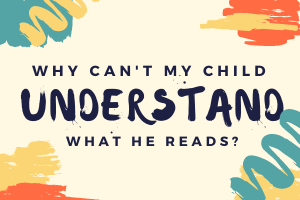As mentioned in my previous article, reading comprehension is a complex process that requires several different skills. Like a machinery with different parts, a breakdown in any area can have an impact on reading comprehension.
Even though the end result is a difficulty in understanding what one reads, the symptoms look quite different depending on the area of deficit. What does a break down in each of these areas look like?

Difficulty in Phonics
If your child has difficulties with decoding, he will have trouble sounding out the words. He may not know that a certain alphabet corresponds with a certain sound. Even if he does, he may have difficulty in blending the letter-sounds together to form a word.
Another telling sign of a difficulty in phonics may be a difficulty with spelling. Since spelling and reading both rely on knowledge of the letter-sound rules, a child who struggles with sounding out words will likely have difficulty spelling words that he hears as well.
Difficulty in Reading Fluency
A difficulty in phonics will almost always lead to reduced fluency. Even if a child is able to sound out the words, a lack of fluency can also impact his understanding. Children with a pure difficulty in reading fluency will read haltingly with atypical stress patterns, even though they are able to talk fluently.
For example, they may take longer than a typical child to read the word, and they may pause at the wrong points in a sentence. As a listener, you will find it difficult to understand what they read.
Difficulty in Vocabulary
After a child has mastered the rudiments of phonics, he is still not out of the woods yet. A child with a difficulty in vocabulary may not understand many words in the sentence. Unsurprisingly, the greater the number of unknown words for a child, the harder it is for the sentence to be understood.
A common indication of a child with such a difficulty is the use of unspecific words like “these” and “that”. In addition, they may over-generalise the use of words. For example, a word like “boy” may be used to refer to all males, including adults and teenagers.
When children presents with these behaviours, it is likely that they do not have the vocabulary to support their needs.
Difficulty in Language
It is quite common for children with a difficulty in vocabulary to also have a difficulty in language due to the inter-related nature of all these skills. A child with a pure underlying language difficulty will be able to sound out words and read them relatively fluently, but is unable to comprehend the story.
Children who present with these traits are what we termed, “hyperlexia”, meaning that they can read better than they can understand. Even though their readings sound sophisticated, their actual verbal output typically consists of very short and simple sentences (e.g. “The boy is running”). This is due to their difficulties in understanding and using complex language structures.
Lack of General Knowledge
A child who shows a lack of general knowledge can probably decode well, and has the ability to use a variety of sentence structures. However, since he has scant knowledge of the topic at hand, he will very likely not have the vocabulary related to the topic. This is because most vocabulary is picked up alongside knowledge.
Very often, a child with difficulties in reading will likely suffer from a lack of general knowledge. Since reading is the best way to amass knowledge, a child who does not enjoy reading will likely not read often. Unless their parents have done a good job in providing them with lots of input (e.g. real world experiences, videos), these experiences are unlikely to fill the void created by a lack of reading.
Unfortunately, this leads to the Matthew effect where the rich gets richer and the poor gets poorer; a child who does not enjoy reading is almost bound to suffer from a lack of vocabulary and general knowledge.

Difficulty in Higher Order Thinking
A child can also have intact general knowledge, language, vocabulary and decoding skills. However, they may struggle with reading comprehension due to their difficulties with higher-order thinking.
Children who struggle in this area often take things very literally and have problems understanding figurative phrases. For example, if they see the phrase “A deer caught in the headlight”, they may get confused as to why there is suddenly a deer in the story.
They may also have difficulties in using their own experiences to make predictions. For instance, when prompted to predict what a boy holding an ice cream will do, they may come up with something out of the ordinary like “The aliens will come and take it.” In this case, the child had used his imagination to derive the answer rather than rely on his past experience to figure out that the boy will most likely eat the ice cream.
In addition, these children may have a difficulty inferring meaning that is not explicitly spelled out. For example, if they encounter the word “The man eats his steak”, they may not infer that he is using a knife and fork to eat it, unless it is indicated in the text.
As you can see, children who struggle with higher order thinking often need everything to spelled out, and they take what is spelled out very literally.
Difficulty in Attention
Children with a difficulty in attention will have difficulties comprehending what they read; not because of a lack of ability to decode or understand, but because the information does not even have a chance to be processed!
A child with problem attending may start to stare out the window after a few minutes. Or they may remain on the same page for a long time. Some of these children may exhibits hyperactivity, where they need to constantly be on the move; whereas there are others who are not hyperactive, but display a lack of focus.
Conclusion
As you can see, a child who experiences a breakdown in one area will look very different from one with a breakdown in another area. In fact, such isolated breakdowns are quite rare. Very often, children come in with difficulties in multiple areas.
The good news is that, these differences can serve as markers to help us identify their areas of weakness, so that targeted support can be provided to help them.
What other signs does your child has that may indicate a reading difficulty? Share them below.


1 Comment
Steps to Teaching Narrative | Speech and Talk Therapy Singapore · March 8, 2021 at 10:45 pm
[…] See also: Reading Comprehension Difficulties […]
Comments are closed.